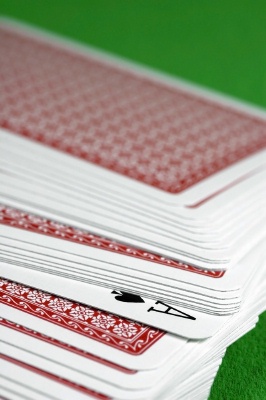|
|

Marked Cards - Playing cards which have had their integrity compromised through secret markings on the card backs.
In a standard poker deck, the back sides of the cards are all identical so that it is impossible to tell the difference between cards
by simply viewing their backs. This is critical for protecting the integrity of the game, and keeps the playing field level for all
players. Some players do not want a fair game, but would rather gain an unfair tactical advantage over their opponents, even if it
means cheating. One of the longest standing and most insidious types of cheating is the use of marked cards.
Players may mark cards in any number of ways. Usually this is done by altering or defacing the back side of the card in a manner that
is only perceptible to the cheater. Card backings often have complex patterns which can provide camouflage for illicit markings. The
cheater may mark the cards by slightly crimping a corner, by scratching their backs with a ring or fingernail, or by marking their
backs with tiny ink spots. In more sophisticated cheating operations, the markings are actually printed into the card backs, but you
have to know where to look for them. These markings allow the cheater to read the contents of his opponents’ hands without being detected.
Sometimes, the card backs can become defaced by accident or through normal wear and tear. If any of the players or the dealer sees any
rouge markings or defacements while the hand is in play, they may request a replacement from the floor man. When the floor man is
called to the game because of a bad card, he may replace the defaced card with a clean one, or change the deck out entirely, at his
discretion. To protect the players, each player is allowed to request that a new deck be put into play if they see or suspect that
anything is wrong with the current deck in play. This can be accomplished by asking the dealer for a “deck change,” or to “change the
deck.” Obviously, the issue of marked cards is limited to
brick and mortar casinos and home games.
Online poker rooms have virtual card backs which cannot be marked.
Most of the markings that you notice will be accidental. It is very rare for a sophisticated marked deck to be caught in a casino,
especially a deck with the marking printed into the card backs. For one thing, casino cheats are subject to arrest and stiff legal
penalties. Also, it is difficult to mark a deck effectively and undetectably while the game is in progress. It is far, far easier to
mark the deck ahead of time, or to use a preprinted marked deck, and then to slip the compromised deck into play. This would likely
require collusion between the cheating player and either the dealer or the floor man, or both. While cheats occasionally do turn up in
the game, cheating rings between players and casino staff are very rare, and often target the house on a large scale rather than the
players on a small scale.
You may be able to tell if the markings on a deck were made accidentally or intentionally. Frequently, a cheater will choose to mark
only few cards in the deck, typically the power cards. Markings that appear only on aces are suspect. Markings that appear on random
lower ranking cards are less so. Most accidental marks are tears or large obvious scratches on the card backs. These markings may only
affect a single card, and if there is more than one bad card, the markings do not appear to be similar or in a pattern. These types of
defacements are almost always accidental. Markings that are made on purpose are by design tiny and nearly undetectable, but if you can
detect them, the often occur in patterns, which make them easier for the cheater to read. For example, all the aces may be marked in
one spot, all the spades in another, and all the face cards in third spot. The cheater can then evaluate these separate markings to
determine the exact cards his opponent holds.
As stated previously, the risk of being cheated by a marked deck in a brick and mortar casino (B&M) or in an online poker room is
negligible. They have sophisticated surveillance and security procedures in place in B&M’s, so that cheating is rarely tried because
the risk of getting caught is too great. This is not always the case for private games or home games, especially those with players
whom you are not familiar with. These games typically have minimal protections against cheaters and teams, and players need to be
alert and aware of the dangers of being cheated. Of course, home games can also be fun, profitable, and on the level, so you should
not assume that you are being cheated, but you certainly need to be aware of the dangers.
Usage: Mark The Deck, Marked Ace, Marked Deck Of Cards
Previous Poker Term: Maniac
Next Poker Term: Marker |
|









